The chest is one of the largest and most beautiful muscle groups in the human body. Literally every teenager who visited the gym for the first time dreams of" pumped up " and massive beautiful Breasts.
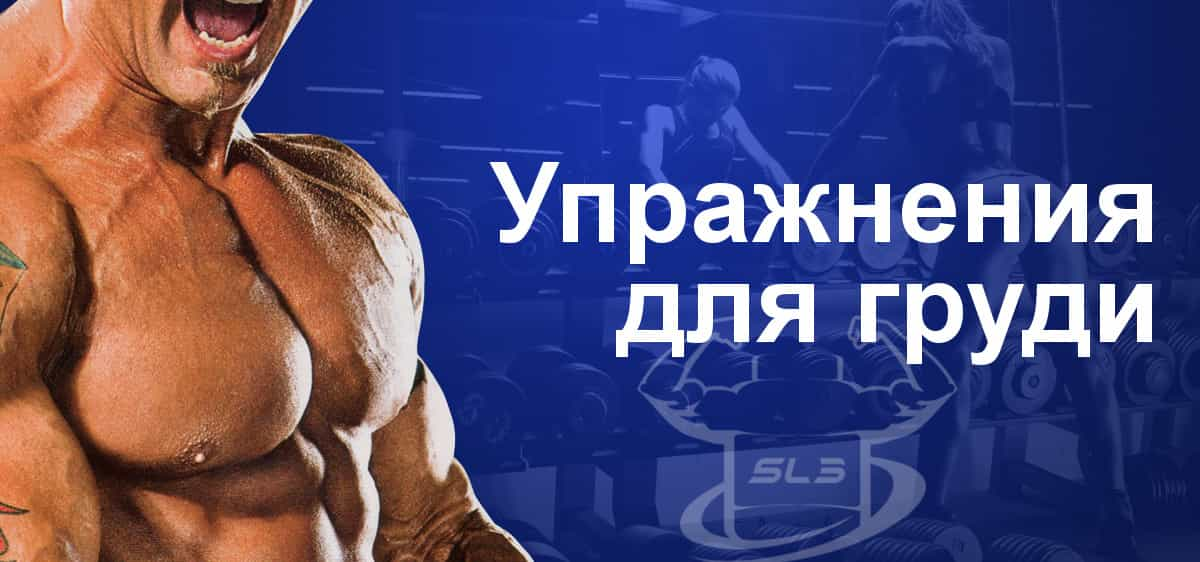
In this article, dedicated to exercises for training the chest muscles, we will consider a set of exercises that effectively contribute to the development of the chest muscles.
Consider the structure of the chest muscles, which is shown in the illustration:
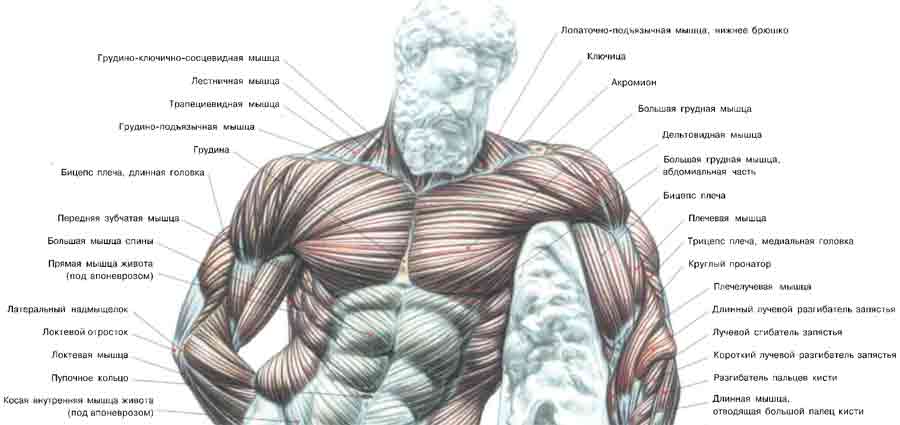
Each of these muscles, in one way or another, is used when performing exercises to develop the chest muscles.
Now let's look at the list of these exercises in more detail:
1. A press of a bar lying on a horizontal bench
Bench press is one of the most popular exercises in the gym, due to the technical simplicity of the exercise and the rapid progress in this movement, provided that the correct technique is followed.
The illustration below shows a diagram of performing a bench press and shows which muscles take part in the work:
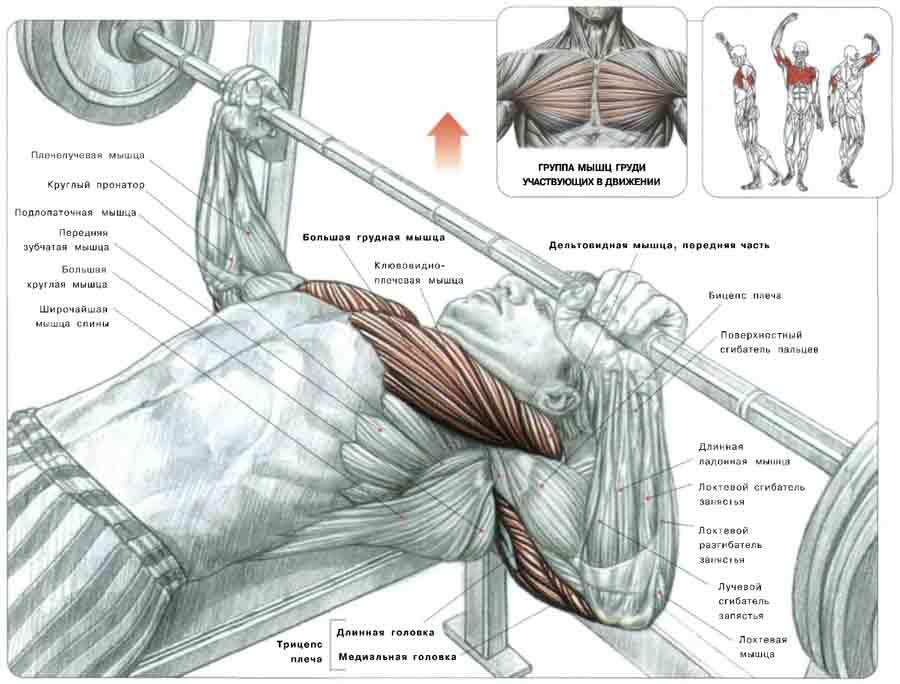
Scheme for performing the bench press:
Lie on your back on a horizontal bench. The buttocks and shoulder blades should be tightly pressed to the surface of the bench, and the feet should be placed on the floor with the entire foot:
- take the bar bar with a grip from above wider than the shoulders;
- take a breath and slowly lower the bar to chest level, controlling the movement;
- squeeze the barbell and exhale at the end of the movement.
The bench press develops the entire pectoralis major, pectoralis minor, triceps, anterior deltoid, dentate, and cranial-brachial muscles.
Necessary conditions for a proper and powerful bench press:
- Firmly and tightly wrap your hands around the barbell neck to give a stable position to your wrists. Hands during the press should stay straight, do not fill them back.
- Keep your head as close to the bench as possible.
- Bend your back at the waist so that your buttocks and shoulder blades remain firmly pressed against the bench. The deflection in the lower back allows you to reduce the trajectory of lowering the bar, and give the chest a position in which the lower part of the chest muscles is maximally included in the work.
- The buttocks should be firmly pressed against the bench during the entire movement, lowering and lifting the bar
- The feet should be stationary, the heels fully pressed to the floor, this position ensures the stability of the torso during the exercise.
Options for performing the bench press:
1. by Bending your back, you will focus the load on the lower parts of the chest muscles and will be able to squeeze out more weight. Perform the exercise carefully to avoid injury to the lower back.
Performing a bench press with an arched back allows you to reduce the trajectory of lowering the bar and helps to lift a heavier weight, since in this case a very powerful lower part of the chest muscles is actively involved, keep your Head and legs stationary. Press your buttocks firmly against the bench. If you have lower back pain, you should exclude this exercise.
2. With your elbows pressed to your sides, you mainly work out the front part of the deltoid muscle and the triceps of your arms
3. Changing the grip width loads:
- tight grip: the middle chest muscles and triceps;
- wide grip: the outer part of the pectoral muscles.
4. Changing the trajectory of the bar neck loads:
- lowering the neck to the lower edge of the chest, work out the lower part of the chest muscles;
- lowering the neck to the middle of the chest, work out the middle section of the chest muscles;
- lowering the neck on the clavicular bundles of the pectoral muscle, work out the upper part of the pectoral muscles.
2. A press of a bar lying on an inclined bench
Bench press - this exercise loads the clavicular part of the pectoralis major muscle, the anterior parts of the deltoid muscles; triceps, anterior dentate and pectoralis minor muscles.
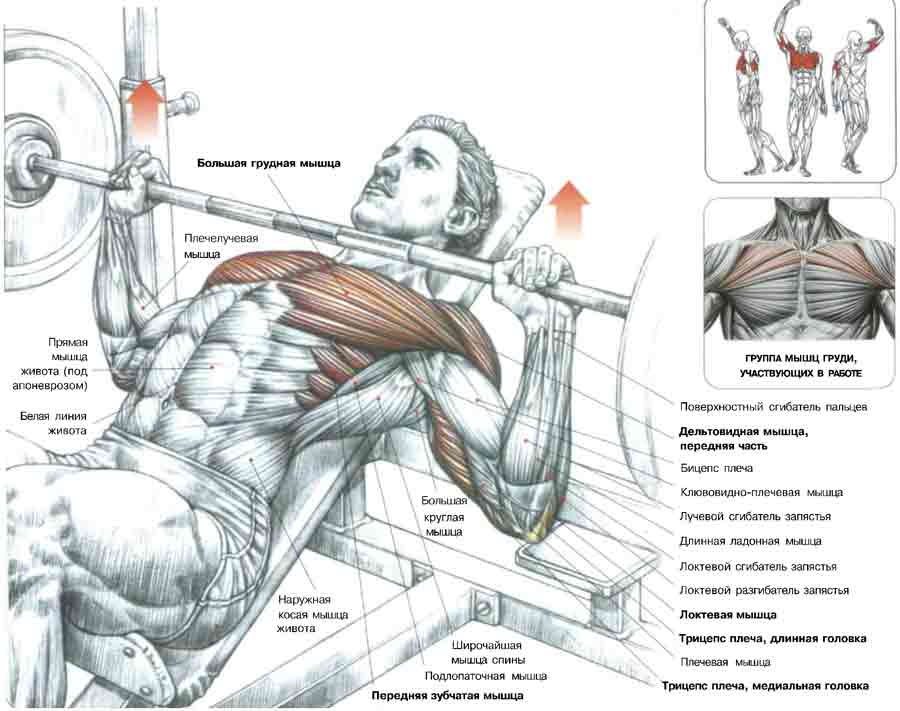
Mechanics of the exercise bench press lying on an inclined bench:
The exercise is performed lying on a bench with an angle of inclination from 45° to 60° (the angle of inclination should be less than 60° in order to avoid too much tension of the deltoid muscles). Hold the barbell bar with a grip wider than the shoulders:
- take a breath and lower the barbell to the level of the collarbone;
- squeeze the barbell until your arms are fully straightened;
- at the end of the movement to make an exhalation.
3. Press the bar with a narrow grip, lying on the bench
The narrow grip barbell press is an excellent exercise that develops and draws the pectoral muscle and triceps well.
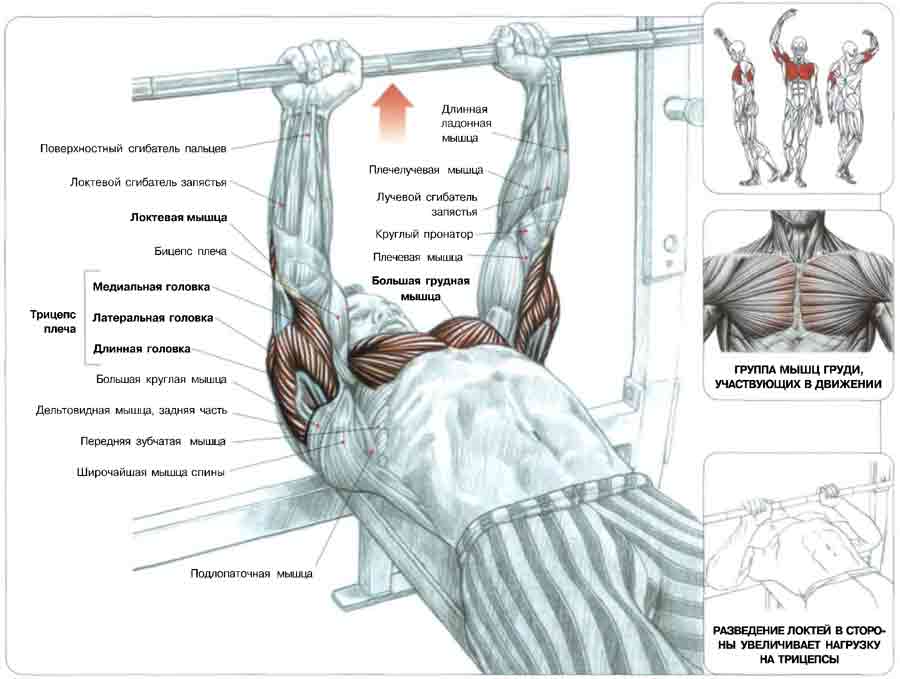
Mechanics of performing the exercise bench press with a narrow grip:
The exercise is performed lying back on a horizontal bench. Buttocks and shoulder blades tightly pressed to the surface of the bench, put your feet on the floor with the entire foot. Take the bar bar with the upper grip with the distance between the hands from 10 to 40 cm depending on the flexibility of your wrists:
- take a breath and slowly lower the bar to chest level, controlling the movement;
- squeeze the barbell and exhale at the end of the movement.
4. A press of a bar lying on a bench with a reverse bias
Bench press lying on a bench with a reverse tilt - exerts a load on the large pectoral muscles (primarily their lower parts), triceps, and the front parts of the deltoid muscles.
Bench press lying on a bench with a reverse slope-perfectly forms the lower undercut of the pectoral muscles. In addition, when lowering the barbell bar to the neck, the pectoralis major muscle is stretched, which helps to increase its elasticity.
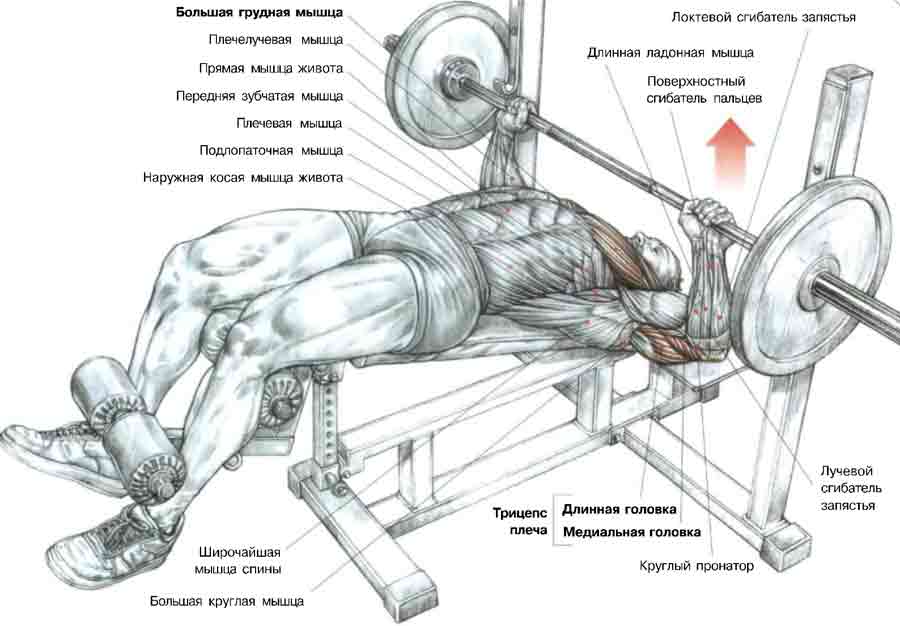
Mechanics of performing the exercise bench press while lying on a bench with a reverse tilt:
The exercise is performed in a position-lying head down on a bench with a slope of 20-40°. Hold the bar bar with a grip on top of the shoulder width or slightly wider:
- take a breath and lower the bar until the lower edge of the chest muscles touches;
- squeeze the barbell out of yourself, exhaling at the end of the movement.
5. Push-UPS from the floor
Push-UPS are exercises in which the contraction of the anterior crenellated muscles presses the shoulder blades against the chest, combining the action of the arms and torso.
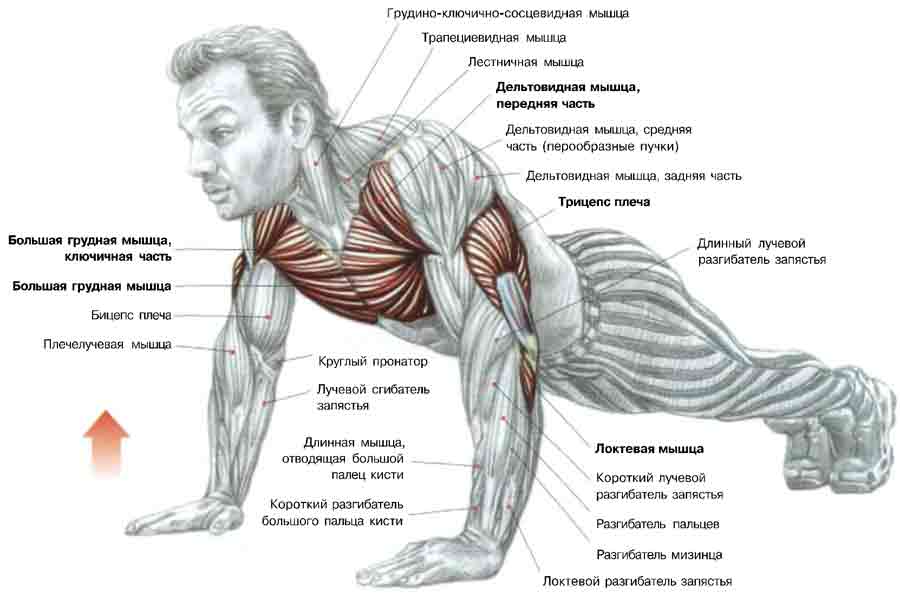
The exercise is performed in a face-down position, resting with straight hands on the floor, palms shoulder-width apart or slightly wider. Feet together or slightly apart:
- take a breath and bend your elbows, bringing the chest to the floor, while the spine in the lumbar region is not strongly arched;
- push up until your arms are fully straightened;
- at the end of the movement to make an exhalation.
Options for localizing the load when changing body positions:
- on the upper part of the pectoralis major muscle: the legs are placed on a raised platform;
- on the lower part of the pectoralis major muscle: when the trunk is raised.
Options for localizing the load when changing the distance between the palms:
- on the outer part of the pectoralis major muscle: with the palms spread wide;
- on the inner part of the pectoralis major muscle: with narrowly spaced palms.
6. push-UPS on uneven bars
Push-UPS on bars are an indispensable exercise that perfectly stretches the large pectoral muscles and increases the elasticity of the shoulder girdle muscles.
It is not recommended for beginners, as it requires considerable effort and reliable, safe movements. For this purpose, you should use simulators that allow you to work out the appropriate technique.
Performing the exercise 10-20 times gives optimal results. To increase the volume and strength of the muscles, experienced athletes hang fixed dumbbells or disks from the barbell to a special belt.
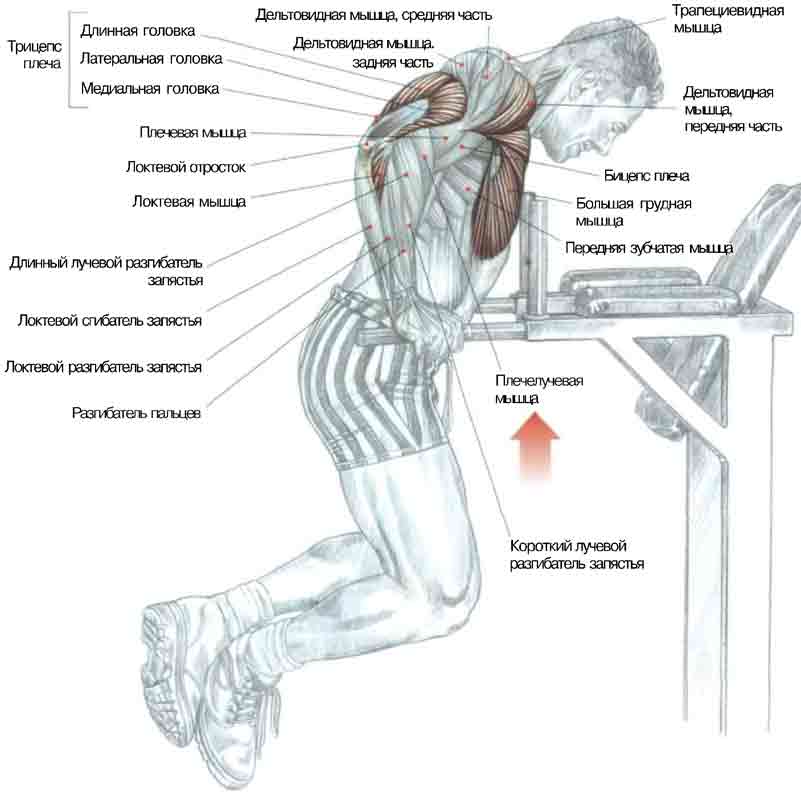
Mechanics of performing push-up exercises on uneven bars:
Leaning on the handles of parallel bars with straight arms, the body in an upright position, the legs overhanging:
- take a breath and bend your arms at the elbows, go down;
- push up and exhale at the end of the movement.
The greater the forward tilt of the torso, the more the pectoral muscles are involved. Conversely, the straighter the torso, the more involved the triceps are.
7. Dumbbell bench press lying
Dumbbell bench press-the exercise is similar to the barbell bench press, except that the dumbbell exercise is characterized by a larger amplitude, which contributes to better stretching of the large pectoral muscles. At the same time, the triceps and the front parts of the deltoid muscles are also involved in the work (although not so intensively).
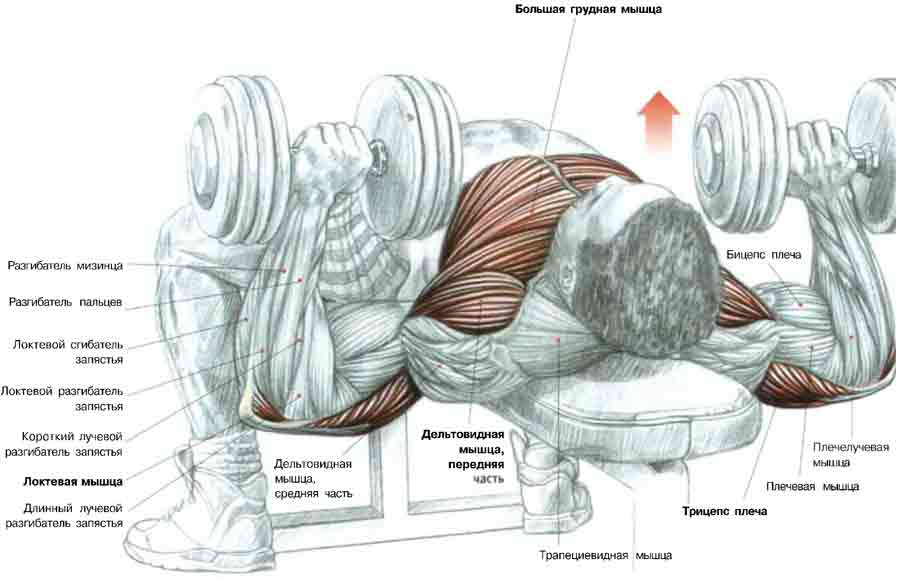
Mechanics do the dumbbell bench press exercises:
The exercise is performed lying back on a horizontal bench. Buttocks tightly pressed to the surface of the bench, put your feet on the floor with the entire foot. Hold the dumbbells in front of your chest bent at elbows and lowered his hands, the brushes are in the position of pronation:
- take a breath and straighten your arms up; turn your forearms, hands facing each other;
- to make the exhalation at the end of the movement.
When the hands are in the desired position, achieve an isometric contraction to focus the load on the inner part of the chest muscles.
8. Breeding dumbbells lying
Breeding dumbbells lying down - this exercise localizes the effort mainly on the pectoralis major muscle. This is a basic exercise for increasing the volume of the chest and helps to increase the volume of the lungs. In addition, it gives elasticity to the muscles.
Mechanics of performing the dumbbell breeding exercise lying down:
The exercise is performed lying back on a narrow bench that allows you to move your shoulders freely. Keep dumbbells on slightly bent arms to reduce their tension in the elbow joint:
- take a breath and spread your arms out to the sides so that your elbows are at shoulder level horizontally;
- raise your hands vertically up while exhaling;
- in the vertical position of the arms, do short-term isometric tension to concentrate the main focus on the inner part of the pectoralis major muscle.
9. Dumbbell bench press lying on an inclined bench
Dumbbell press lying on an inclined bench - this exercise is like an intermediate exercise between the barbell press, lying on an inclined bench, and the dumbbell breeding on an inclined bench and involves primarily the clavicular parts of the pectoral muscles. It also involves the anterior deltoid muscles, the anterior crenellated muscles, and the pectoralis minor muscles (holding both shoulder blades and allowing the arms to interact with the torso), as well as the triceps, but to a lesser extent, unlike push-UPS with a barbell.

Mechanics of performing the dumbbell press exercise while lying on an inclined bench:
The exercise is performed lying on a bench with an angle of inclination from 45° to 60° (the angle of inclination should be less than 60° in order to avoid too much tension of the deltoid muscles). Keep dumbbells near the chest in the hands lowered down, bent at the elbows, the hands are in the pronation position
- take a breath and straighten your arms up;
- to make the exhalation at the end of the movement.
10. Raising dumbbells while lying on an inclined bench
Raising dumbbells while lying on an inclined bench-the exercise localizes the effort mainly to the upper parts of the pectoralis major muscle. Along with pulling a dumbbell or barbell ("pull-over"), this exercise is basic for increasing the chest.
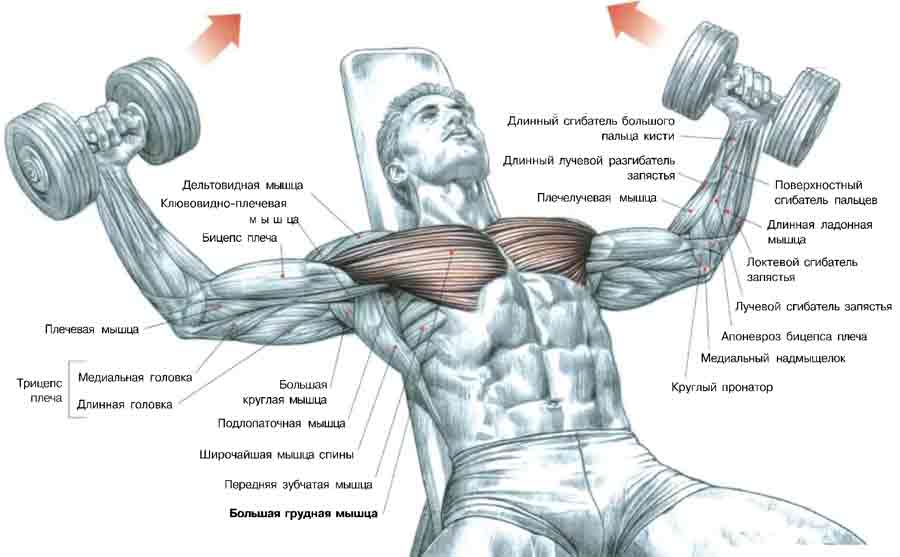
The exercise is performed sitting on a bench with an angle of inclination from 45° to 60°. Keep dumbbells on slightly bent arms to reduce their tension in the elbow joint:
- take a breath and spread your arms out to the sides, so that your elbows are at the same horizontal level with your shoulders;
- raise your hands vertically up while exhaling;
- in the vertical position of the arms, do a short-term isometric muscle tension to concentrate the effort on the clavicular part of the pectoralis major muscle.
11. pull dumbbells lying down from behind the head " PULL-OVER"
Dumbbell pull from behind the head "PULL-OVER" - the exercise develops the inner part of the pectoralis major muscle, the long head of the triceps, the large round muscle, the broadest back muscle, as well as the anterior dentate, rhomboid and small pectoral muscles. These last three muscle groups give the shoulder blades a stable position.
This exercise can be performed to strengthen the chest.
To avoid overloading the triceps, use light dumbbells.
If possible, lie across a horizontal bench so that the pelvis level is lowered below the level of the shoulder girdle.
It is very important to take a deep breath before moving, and exhale only at the very end of the movement.
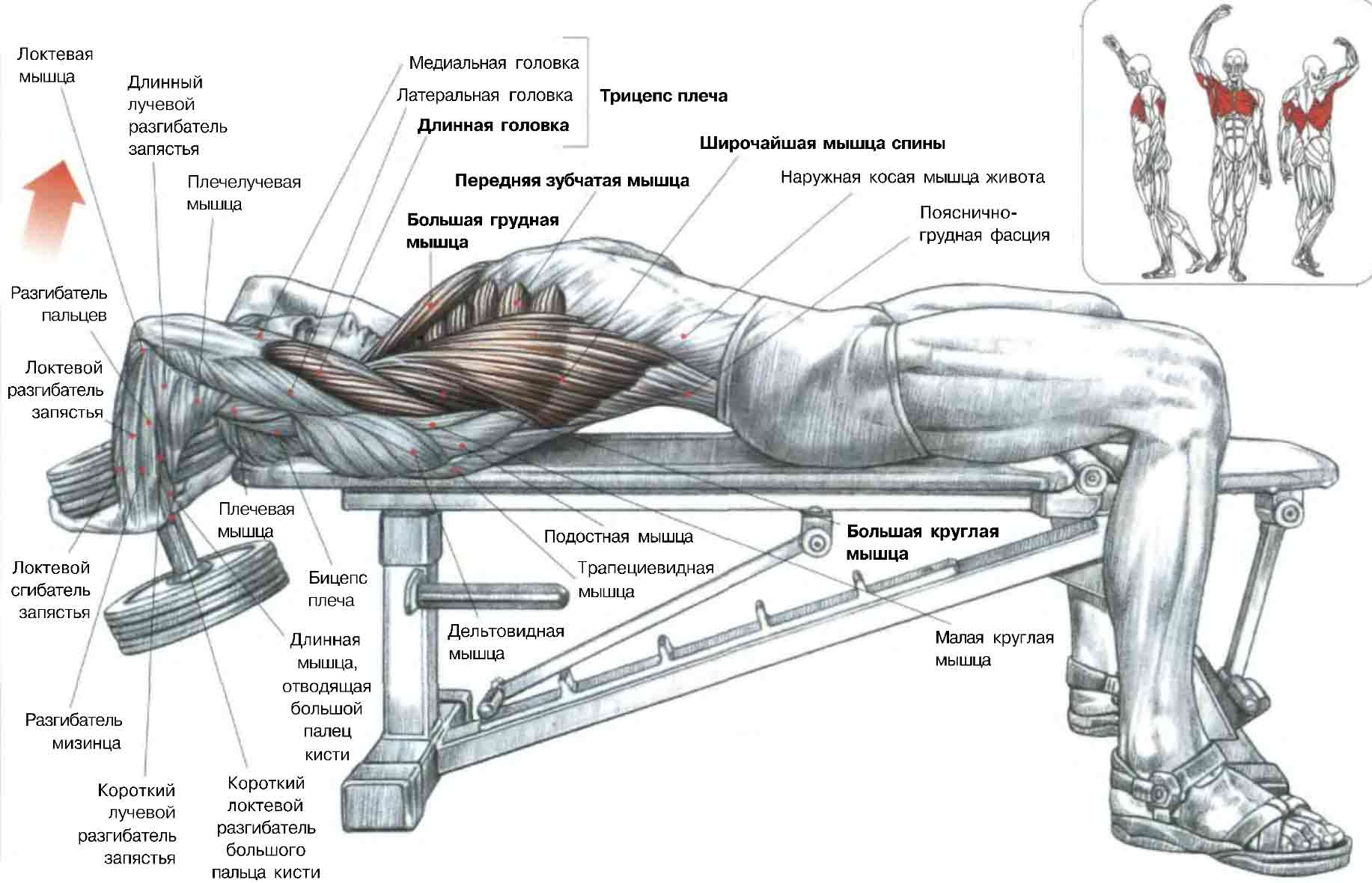
Mechanics of the exerciseDeadlift dumbbells lying down from behind the head " PULL-OVER":
The exercise is performed lying on a bench. Put your feet on the floor. Hold one dumbbell with both hands on straight arms; place your palms on the inner surface of the dumbbell discs. Grip the dumbbell handle with the thumbs and forefingers of both hands:
- take a breath and lower the dumbbell behind your head, slightly bending your elbows, then return to the starting position, straightening your arms;
- at the end of the movement to make an exhalation.
12. Pull rod lying "PULL-OVER"
Pull-OVER: this exercise develops the pectoralis major, long head of the triceps, large round muscle, broad back muscle, as well as the anterior crenellated muscles, rhomboid muscle, and small pectoralis muscle.
It perfectly expands the chest.
When performing it, use light weight loads and monitor the position of the torso and correct breathing.
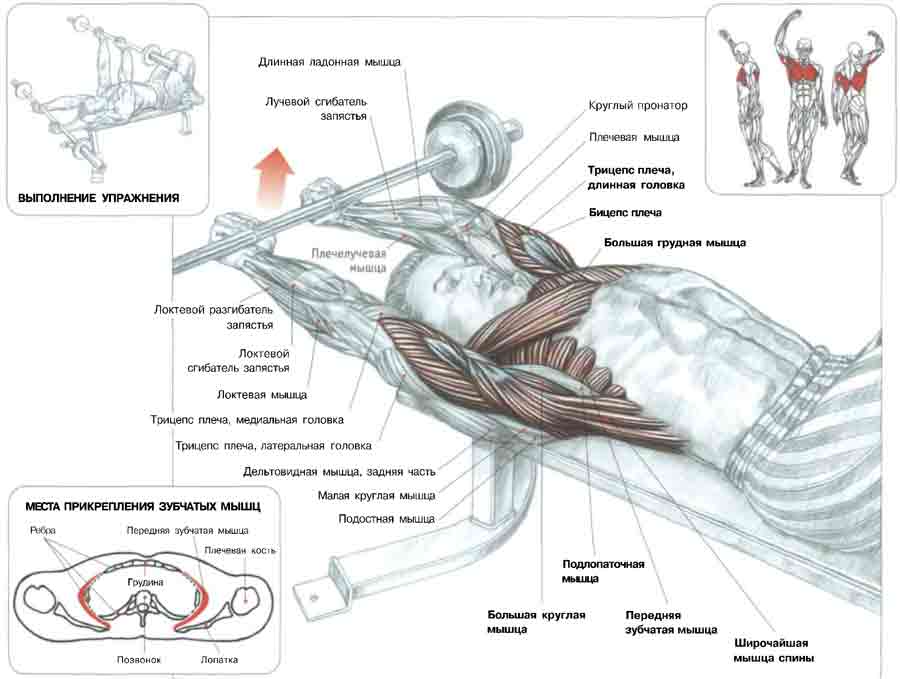
Mechanics of the exerciseDeadlift "PULL-OVER"":
The exercise is performed lying on a bench. Put your feet on the floor. Hold the bar bar with straight hands and a grip from above no wider than the shoulders:
- take a breath, fill your lungs with air as much as possible, lower the bar behind your head, slightly bending your arms at the elbows;
- at the end of the movement, returning to the starting position, exhale.
Here is a list of the main exercises aimed at developing the chest muscles. This list contains only basic exercises with free weights, barbells, and dumbbells. In addition, there are a lot of exercises for the chest muscles, which are performed in specialized simulators....these exercises are designed specifically for additional training of the chest muscles.
Buy sports nutrition for the growth of breast muscles you can in the online store of sports nutrition 5LB.UA.
The illustrations for the article are taken from the book "Anatomy of strength exercises"by Frederick Delavier.
7 reviews / Write a review

